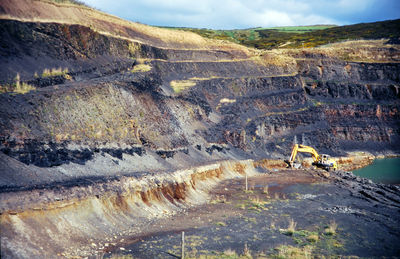Pennines and adjoining areas - Coalfield areas
This area includes the two large coalfield areas that flank the Pennine Hills (Figure P902265). The South Lancashire Coalfield in the west encompasses the predominantly industrial and urbanised tract of land between Liverpool (Merseyside), Burnley (Lancashire), and Manchester, and extends southwards to Macclesfield in Cheshire. The East Pennine Coalfield area runs from Leeds and Bradford in West Yorkshire, southwards past Sheffield (South Yorkshire) and Chesterfield (Derbyshire) to the western part of Nottinghamshire. A third small coalfield occurs near Ingleton.
Sedimentary bedrock

The sedimentary bedrock of these areas contains coal resources and comprises a thick sequence of layers known as the Coal Measures, which rest on top of the slightly older sediment layers found at surface in the centre of the Pennines and the Peak District. These rocks formed in shallow and deep seas, with vast quantities being transported by large river deltas. Occasionally the tops of these deltas were exposed, which allowed massive swampy forests to develop. After burial the vegetation from these forests was compressed to produce thin layers of coal. The Coal Measures are locally present at depths exceeding 1500 m in south Lancashire between Liverpool and Manchester, and 1250 m to the south of Leeds in the East Pennine Coalfield. At Ingleton these rocks are only about 200 m thick.
The Coal Measures are formed by varied sedimentary rocks including grey-coloured mudstone and sandstone, with individual layers rarely exceeding 50 m, and individual beds of coal typically up to 2 m thick. Some of the sandstone layers within these sequences are aquifers, providing minor amounts of water for local public supply. In southern parts of the South Lancashire Coalfield, at Ingleton and in the eastern part of the East Pennine Coalfield, at depths of up to 350 m, these rocks are overlain by reddened rocks, known as the Warwickshire Group, in which limestones are also developed and the coal seams become rare. The gradation from grey, coal-bearing rocks to reddened rocks is due to change at the time they were laid down from tropical swamps and deltas, through to better-drained areas where soils developed as the sediments became exposed to the air.
The Coal Measures and Warwickshire Group have been extensively mined in the past for coal, iron (from iron-rich layers called ironstones), fireclay (Plate P774911), limestone (with various uses including as a flux in steel-making) and sandstone for building purposes and as a crushed aggregate. The coal-mining industry is now largely redundant having been in decline since the early 1900s, with deep mining having ceased at Ingleton in the 1930s and in south Lancashire in the 1990s. Only three deep mines are currently operational in the East Pennine Coalfield near Mansfield, Nottinghamshire, and between Doncaster and Leeds, from the thousands of mines that have been worked previously; the potential for further deep mining remains a remote possibility. Most deep coal-mining operations have taken place at depths up to about 800 m below surface, with workings accessed by vertical shafts cut through the overlying rocks. Mining for coal has caused surface subsidence in some areas that have been undermined. Natural methane gas is produced from disused coal mines in numerous locations in the East Pennine Coalfield between Mansfield (Nottinghamshire) and Castleford (West Yorkshire).
Basement rocks are not encountered near the surface in the coalfield areas but occur at several kilometres depth over much of these areas.